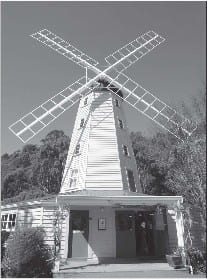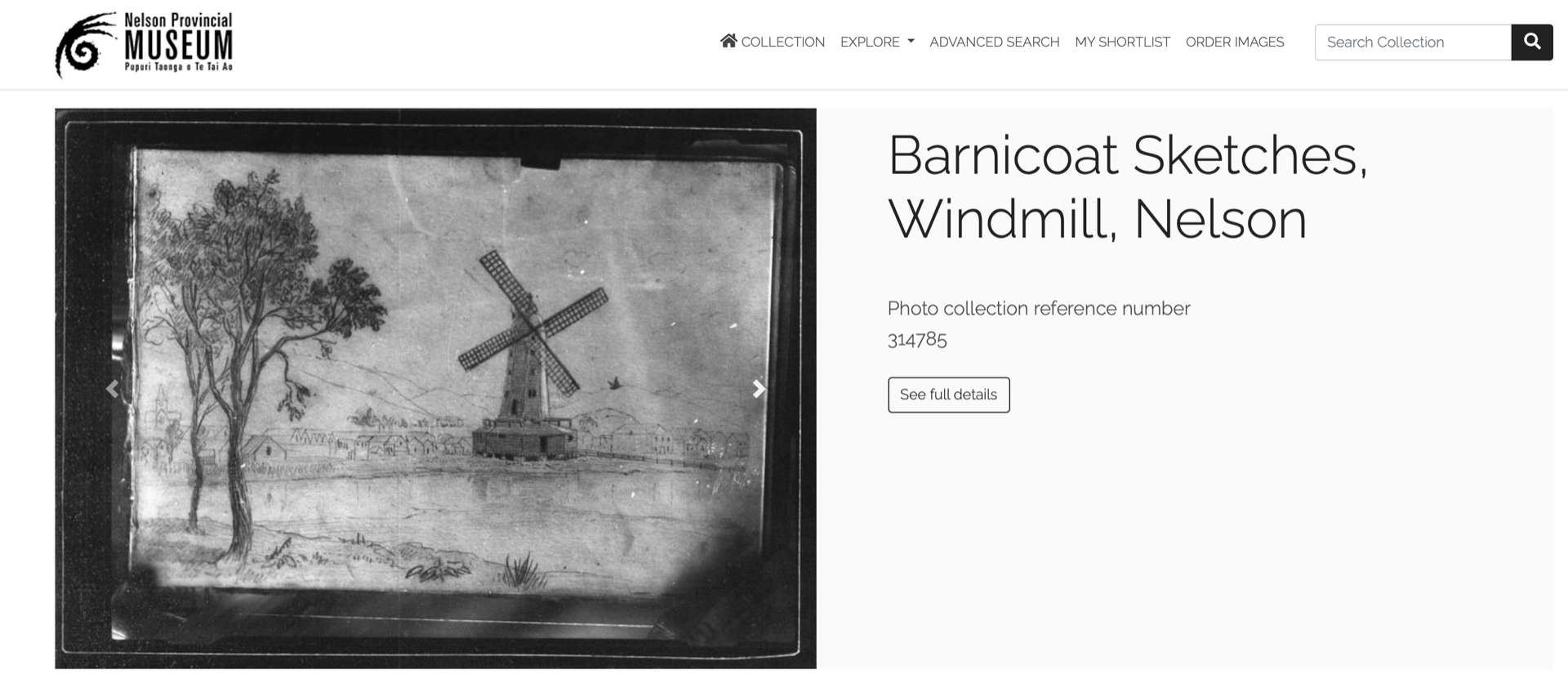The Auction
It starts with a buzz around an auction. A painting of a windmill has appeared at Auckland’s International Art Centre signed by Edwin Harris. Oil on canvas, Landscape with Windmill measures 16.5 x 24 cm and depicts a peaceful scene, cloudy blue sky up above, a softly looping road with a cart, sparse foliage in the foreground, the tops of reddish roofs, and of course the windmill.

The dates given for the artist (1855-1906) don’t match our Edwin Harris (1806-1895) but that doesn’t necessarily mean it isn’t a match. A painting by our Edwin Harris (1806-1895) of the Interior of St Andrews Church in Plymouth, England was originally attributed to that Edwin Harris (1855 – 1906). The story is told in ‘Edwin Harris, Interior of St Andrew’s Church, 1825’ (2019).
The next step is to look for windmills in Edwin’s work starting with the two sketchbooks now in the possession of Harris descendants Godfrey JW Briant and Roseanne Cranstone.
Appearance 1: The Sketchbooks
The Cranstone sketchbook doesn’t have any windmills but the Briant sketchbook has a windmill sketch, not a match for the auction painting, but for a scene in Nelson.

Dr Bush’s windmill began operating in Nelson in 1853, ceased operation due to unprofitability in 1862, sold in 1865 and was then destroyed by fire in 1867 (The Prow). Which gives a 14 year window dating the sketch between 1853 – 1867. Since Edwin Harris relocated to Nelson from Taranaki in 1860, we can be fairly sure the sketch dates from the later part of the windmill’s career. Now we discover that Nelson’s Founders Park contains a replica of Dr Bush’s windmill, giving us an idea of how the windmill would have looked close up and the detail which Edwin was able to capture even at a distance:

Appearance 2: The Barnicoat Sketches
The Nelson Provincial Museum has a photograph of Edwin’s Nelson windmill sketch. Upon finding it I flicked back and forth between the Briant sketch and the NPM photo of it confirming with bemusement that it was a match, down to the bird mid-flight, but it was identified as ‘Barnicoat Sketches, Windmill, Nelson.’ It turns out there’s several photographs of sketches in the Nelson Provincial Museum that are Edwin’s, exact copies of pages from his sketchbooks, but they’re identified as ‘Barnicoat sketches’ alongside the actual Barnicoat sketches,, a collection that ranges from landscapes and character sketches to diary pages. John Wallis Barnicoat (1814-1905) was a Nelson surveyor and politician, his journals chronicled his voyage to Nelson and his time surveying and are held at the Alexander Turnbull Library. And in the midst of Barnicoat’s pages at NPM, we unexpectedly find Edwin Harris. At some point, pages from Edwin’s sketchbooks and Barnicoat’s material have coalesced at the Nelson Provincial Museum.

Appearance 3: PapersPast
The NPM photograph of Edwin’s sketch, now correctly attributed, also turns up in the Nelson Evening Mail in 1930, more than three decades after the artist’s death in a retrospective of the early days of Nelson:


The sketch, one of two (the other not by Edwin), accompanies an article called ‘When Settlers Arrived: Pen Pictures of Early Days’ which contains settlers descriptions of the landscape and a recounting of the history of Māori living in the area. The windmill having long since burned down, the sketch captures the Maitai rivebank in Edwin’s time for readers in 1930. The sketch in the Nelson Evening Mail is also one that James Chappell may have looked at as he designed the Founders Park replica more than five decades later in the 1980s:
Chappell had little to go on when he began planning the windmill for the park that opened in 1986.
The windmill is a replica of the one built on Miller’s Acre in 1853. In 1867, sparks from a nearby steam engine shed sparked a fire, and the wooden structure burned to the ground.
“Very few photos of the windmill have survived; from those old pictures I was asked to draw some plans,” Chappell said.
Time and representations layer up on themselves. Edwin’s sketchbook, the photo buried deep in the NPM archive, the online newspaper on PapersPast and somewhere that article and sketch sitting in print. The long burned down windmill and the replica still standing. And looping back to an auction, staring at a windmill on my laptop screen
So is it our Edwin?
Looking back at the auction painting, even with it being a different scene and location, I don’t know if I would say this was our Edwin’s work. Edwin Harris is often exacting with detail, particularly when it comes to buildings and structures, drawing and painting with a sharp quality that conveys the straightness of the windmill’s sails, the edges and slopes of the structure, the neat lines of the surrounding buildings. There’s not enough there to say that it’s our Edwin’s and not enough to completely erase the possibility that it is. Mystery prevails.
Lead writer: Brianna Vincent
Research support: Michele Leggott